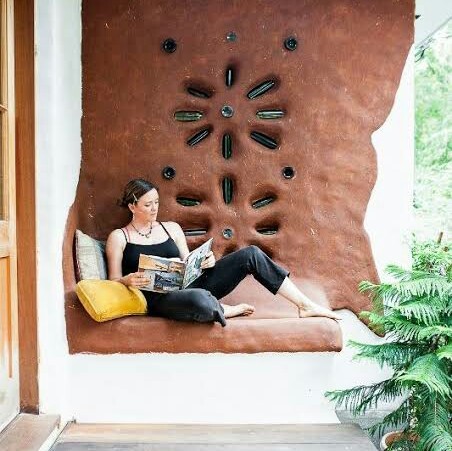#tipiliving
Text
Gardening for Extraterrestrials - Late summer on the tip of Africa with still plenty of planting season left!
If you beat the weeds and cleared some space in your garden to plant some types you would rather have in your garden instead, then the last stretch of summer heat without rain might have been very discouraging. Baby plants, like any other babies, needd a temperate and moist environment.
To add to the challenge of drought conditions all over the Highveld and beyond, there are signs of Autumn’s approach in the drying up of squash plants and leaf fall off some deciduous trees.
Don’t be put off, chin up, get your best sun hat on and get ready to make use of the rain that is coming. Store up as much water from the rain when it comes, for when there is no rain. There is plenty of growing season ahead. Escarpment areas have some advantages on the Highveld and you can grow a lot before the first frost, potentially only arriving in May!
This is what you can do this February. Choose short life summer veggies, like lettuce, spinach, and even tomatoes and germinate them in medium pots for a little longer stretch than in a shallow seed tray. Water repeatedly for the dry days, morning and night.
Plant peas and carrots in deep seed trays and ready a bed where they can grow together. Grow the peas on a line trellis or fence edge with carrots in lines between them. They both like the cooler weather and if you find a shady edge under a tree that will lose its leaves and let sun through in the winter, you can give them a longer growing period.
If you can control insect invasion with shade net, plant a variety of brassicas (Cabbage, Cauliflower, Broccoli, Brussel Sprouts and Kale) in deep seed trays and water well. They love the cooler winter months and can feed you very well with enough to share. They like a rich nitrogen soil, being that they are leaf based. Plant them out at a distance that prevents them from having so much space between them that the sun dries them out and the water you give them gets wasted. Imagine the size of a cabbage head and space them as close as that.
If it helps to save you time, it is not recommended that you plant corn now. Not onions or garlic either. Don’t let me stop you from trying but consult your seed packets for suggested planting months and how long they take from seed to plate.
Send in your garden successes or challenges in the comments below or email me here, and let us know if there is something you want to know about. Maybe you are not growing vegetables, but rather soft lawns and roses instead. Share your particular garden skills and feature your garden here on the Garden School page.
Follow us on the Garden School (@gardenschoolboven) on Facebook.
Happy gardening!
#gardening#South Africa#permaculture#mpumalanga#vegan#organic#foodforest#vegetable gardening#garden school#gardening tips#offgrid#tipiliving
4 notes
·
View notes
Photo

The big chief is back & he’s spectacular🏕⛺️💙 #bigcheif #indianheaddress #tipiliving #leaderofthepack #chief #costumesyeppoon #costumesrockhampton #instadaily #yeppoon #costume #costumes #indiancostume #indian #nativeamerican #party (at Bling Bling Costumes) https://www.instagram.com/p/Br_lqAGHVVn/?utm_source=ig_tumblr_share&igshid=1vrbslspws20y
#bigcheif#indianheaddress#tipiliving#leaderofthepack#chief#costumesyeppoon#costumesrockhampton#instadaily#yeppoon#costume#costumes#indiancostume#indian#nativeamerican#party
0 notes
Text
Natural Building 101
3 Part Natural Building course from beginner to advanced at the Brown Earth Venue, Mpumalanga South Africa
You’ve seen it on YouTube now get down and dirty and raise a build from the ground up! Naturally!
Looking back on the ‘conveniences’ brought in by the industrial revolution, I have often wondered if things could be a bit simpler.


A stunning example of raised beds built naturally from
You don't have to build a house with Natural Building methods, raised beds and garden furniture is very rewarding!
Production line building materials that fit exact measures are all good and well but what if the trees and the Earth right under our feet could shelter us for less than the petrol cost of getting said materials delivered, never mind the labour and skills required to put it all together with no leaks and a stunning finish.
We are anything but builders, IT geeks and legendary anarchists in our own minds, but however misguided we might be, we left the city, took responsibility for my folks in the face of empty challenges and went for spring water and no debt, living off grid on a hillside in Africa, on the escarpment in Mpumalanga.
Biting into the reality that is community living, in South Africa, experiencing a digital reality while facing physical mass extinction, artificial intelligence while immersed in pure nature, living outdoors 24/7 with my life partner and two children.
We are testing our assumptions and this year the assumption we are testing is Natural Building as a viable development strategy on our remote piece of land up a rocky path.
(Pause here and search this hot topic on your favourite browsing platform — you won’t be disappointed if you are new to this idea, and what’s more, you CAN do this yourself.)
We have found a Natural Building facilitator after trying for a long time to position ourselves in the right place to realise this dream. Michael Errol Saunders from Uniondale in the Cape, will be changing our lives for the next seven months and we’re thrilled to have him and am so grateful for his enthusiasm to collaboration with us.
Join us! For beginner, intermediate and advanced workshops make up our Natural Building Course.
If you are not rolling in cash but rich in creative ambition, this series of workshops could set you free; no prior experience required.
From beginner to advanced, get a grip on what you can do if you don’t have a big budget alongside a big dream to build anyway!
The 3 part course will run twice over the next 7 months so you can book for the individual workshops or book all three in succession to get the advantage of discounted booking and certificate. You can get all three done in as quickly as three months or do the workshops spaced out until September.
The beginner workshop is 5 days and covers:
Introduction to Natural Building through theory and practical, addressing various methods of Natural Building, soil composition, testing and sampling, foundations, roof covering, furnishings. With practical Adobe brick manufacturing, foundation building and straw-bale construction.
Cost per person includes:
R4880pp includes camping and lunch per day and workshop notes and facilitation
The intermediate workshop is 7 days and covers:
Theory and practical, addressing Cordwood Construction, rammed Earth, setting out and leveling, insulation and waterproofing. Practical Adobe wall construction , bottle cutting and building bottles in and Adobe arch construction. Practical installation of windows and door frames , scratch plaster, agricultural drains and swales, form plaster, light Earth & slip and practical counter and furniture construction
Cost per person includes:
R6220 includes camping and lunch, facilitation and course notes
The advanced workshop is 5 days and covers:
Theory and practical addressing living off the grid, in depth lecture on solar energy and wind turbines, clay oven foundations and walls, passive solar and alternative methods of heating and cooling, floor construction, ceilings and roof construction design with certificates awarded to those completing the full course (beginner, intermediate and advance).
Cost per person includes:
R4880 includes camping and lunch, facilitation and course notes
Schedule of workshop dates:
22–26 March — 5 day beginner’s workshop
9–15 April — 7 day intermediate workshop
18–22 April — 5 day advanced workshop
15–19 May — 5 day beginner workshop
22–28 May — 7 day intermediate workshop
14–18 June — 5 day advanced
21–25 June — 5 day beginner
10–16 July- 7 day intermediate workshop
19–23 July — 5 day advanced workshop
9–15 August — 5 day beginner workshop
17–23 August — 7 day intermediate workshop
20–27 September — 5 day advanced workshop
Venue details and travel share board:
The Brown Earth Venue is the result of a long imagined hope for the future and 2 years ago we moved here from urban living most of our lives. We’ve always walked alternative paths and now we can share the experience with you if you are considering radical solutions as we have. we have YouTubed the topic to exhaustion and can only really carry on if we get on with it.
If you select the camping option, you will have access to two shared flush toilets, two outdoor showers with fire heated water from a hot water ‘donkey’, camping on the lawn at the main farm house and spectacular views. There are compost toilets up at the development area.
My family and I live in the tipis a little up the hill from there where most of the natural building will take place.
We have spring water on tap that is safe to drink. We are in one of the most popular rock climbing, mountain bike and hiking areas in Mpumalanga. Not only that, we are blessed with historic mysterious Stone Circles in the area with the famous Adam’s Calendar in Kaapsehoop, 40kms away. If you select to do two workshops back to back, check your favourite travel sites for places to visit on the 2 day break in between or ask us and we can recommend many.
Follow me on instagram as vivbrownearthchild
Find progress on the Brown Earth Facebook page here
or email me directly on [email protected]
#natural building#permaculture#wwoof#south africa#mpumalanga#waterval boven#emgwenya#super adobe#wattle and daub#strawbale construction#construction#mud building#brown earth venue#off grid living#primitive technology#tipiliving#rocket stove#clay oven#pizza oven#mbr#rock climbing#psr
2 notes
·
View notes